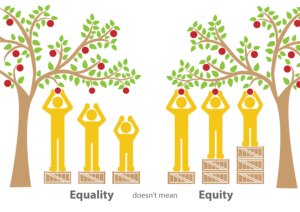This post is part of the Hogg Foundation’s “3 Things to Know” blog series, which explains concepts influencing community mental health and our grantmaking. Check out others in this series: Social Determinants of (Mental) Health, Well-Being, and Resilience.
To have a productive conversation about health equity, we need to get one thing straight: equity is not the same as equality.
Striving for equality alone can actually perpetuate disadvantage. To remedy health disparities, some communities need more—not just equal—resources. Watch this brief illustration from the Robert Wood Johnson Foundation to get clear on equity vs. equality.
Truly attaining the “highest health of all people” starts with embedding fair opportunities for well-being into the whole of community life. The factors affecting health outcomes, collectively known as social determinants of health, include everything from socioeconomic status to the availability of public transport and recreational space—a mix of structural conditions that impact the physical and mental health of individuals and their communities.
Health equity is achieved when our knowledge of social determinants is put toward the cause of eliminating health disparities. But what does a commitment of that magnitude look like, and how can it be fulfilled? Below are three things that anyone wrestling with these questions should keep in mind:
1. Access for all doesn’t mean health for all.
In the U.S., envisioning and enacting systems-wide change requires challenging a long legacy of exclusionary policies, practices and structures that, to this day, derail health improvement for all. When it comes to finding and obtaining health or mental health services, historically marginalized populations know better than anyone that injustice, and lack of opportunity, can persist even in the absence of explicitly discriminatory legislation.
Georges C. Benjamin, executive director of the American Public Health Association, wrote that for health equity to be even remotely possible, we “must listen more to the people we serve, have uncomfortable conversations, and increase our push for social justice.” He’s right to call those conversations uncomfortable; after all, transformational change can’t happen without a willingness to confront the status quo—and our own complicity with it.
But the discomfort needn’t be a road block. In a recent episode of the Hogg Foundation’s Into the Fold podcast, “Understanding Rural Communities,” mental health expert Dennis Mohatt emphasized the importance of building safe spaces—clinical or otherwise—where tensions aren’t censured, but are talked out and felt through. The challenge is bringing that personalized environment into institutional domains and turning them into spaces of inclusivity and equity.
2. Community context matters.
Textbook history is one thing; the true history of a neighborhood or community is quite another. In bringing the intergenerational consequences of social determinants to life, stories of trauma and resilience from the past and present provide a rich, much-needed context for health equity interventions.
Community context, when navigated with compassion and care, serves as a potential bedrock for building empathetic relationships between community members, health workers and other stakeholders. Founder and CEO of Alliance for Greater Works Sherrye Willis, who coordinates the Hogg Foundation’s Collaborative Approaches to Well-Being in Rural Communities (WRC) initiative, calls this “cultural humility”—a way of leading and facilitating programs that celebrates difference.
Equity-driven pilot programs and case studies of the last decade show the unequivocal importance of establishing trust. Underserved populations are understandably wary of top-down agenda-setting, and building an equitable and culturally competent ecosystem of health supports demands the deep involvement of those who know their community best.
3. We’re all in this together.
Without cross-sector collaboration, achieving health equity is impossible. Fragmented systems and services—education, economic development, housing and so on—are far more likely to create disparities than those working in partnership with one another.
Because each and every one of these agencies operates in service of their community, the strength of cross-sector coalitions depends on effective engagement efforts. Just as the investment and participation of community members is needed to create a context for health equity interventions, it’s also needed to shore up a sustainable plan that can continue to play out long after funders and service providers step aside.
Community members that participate in decision-making processes designed to improve their well-being get the added benefit of hands-on training—in the art of both negotiation and advocacy. Though health equity may seem like a lofty goal, it becomes achievable when people are included in the conversation and equipped with the tools they need to leverage their most important resource: themselves.

